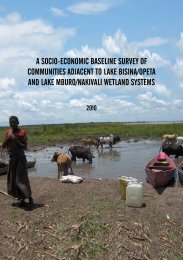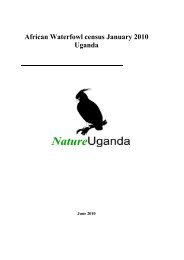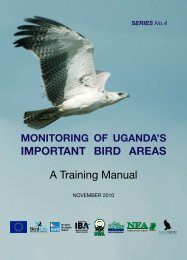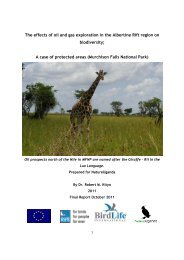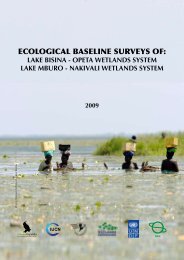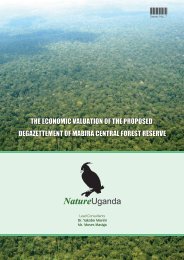Status and Trends 2009 - Nature Uganda
Status and Trends 2009 - Nature Uganda
Status and Trends 2009 - Nature Uganda
Create successful ePaper yourself
Turn your PDF publications into a flip-book with our unique Google optimized e-Paper software.
Major Recommendations<br />
Chapter Five<br />
<strong>Nature</strong>Ug<strong>and</strong>a<br />
• Identify, assess <strong>and</strong> qualify more sites for inclusion as Important<br />
Bird Areas for example Kibimba Rice Scheme <strong>and</strong> extend the<br />
boundary of Mabamba Bay to include Makanaga, a vital new<br />
annex.<br />
• Train Site Support Groups, Parish Extension Agents <strong>and</strong> key<br />
individuals in IBA monitoring <strong>and</strong> basic steps in biodiversity<br />
assessments. This should include mainstreaming Common<br />
Birds Monitoring, L<strong>and</strong> Bird Monitoring, Raptor Censuses <strong>and</strong><br />
African Water Fowl Censuses into the IBA monitoring program.<br />
• Continue advocacy for the different Key Biodiversity Areas <strong>and</strong><br />
raise their profiles locally <strong>and</strong> internationally.<br />
• Appropriately <strong>and</strong> effectively coordinate the process of IBA<br />
monitoring aimed at ensuring long term sustainability.<br />
• Consolidate the wetl<strong>and</strong>s restoration programs in Key<br />
Biodiversity Areas where it has been started <strong>and</strong> initiate it in<br />
areas that require immediate action.<br />
• Continue the process of negotiating CFM agreements in<br />
collaboration with NFA <strong>and</strong> ensure that the agreements are<br />
abided by when signed.<br />
• Source funding <strong>and</strong> support income generating activities within<br />
communities living in or near IBAs <strong>and</strong> enhance conservation of<br />
these areas.<br />
• Where appropriate, establish SSGs <strong>and</strong> empower them to the<br />
level of protecting the site <strong>and</strong> monitoring <strong>and</strong> reporting illegal<br />
activities.<br />
• Initiate <strong>and</strong>/or participate in development of management plans<br />
for IBAs that still do not have them <strong>and</strong> advocate for proper<br />
implementation of plans when developed.<br />
• Negotiate with the local government <strong>and</strong> local communities for<br />
appropriate bye-laws <strong>and</strong> empower the communities to observe<br />
the bye-laws to protect sites.<br />
UGANDA WILDLIFE AUTHORITY<br />
• Monitor <strong>and</strong> reduce incidences of agricultural encroachment<br />
(small holder farming) especially in Ajai Wildlife Reserve.<br />
• Monitor <strong>and</strong> prevent incidences of wild fires especially in<br />
savannah national parks (MFNP, KVNP <strong>and</strong> LMNP).<br />
• Manage the resource harvesting <strong>and</strong>/or access by the<br />
communities <strong>and</strong> ensure that the agreements are adhered to.<br />
• Initiate <strong>and</strong> properly manage the alien or invasive species that<br />
threaten the ecological health of the habitats.<br />
• Monitor the oil exploration activities in the national parks <strong>and</strong><br />
ensure that there are no detrimental effects to the biodiversity.<br />
• Incorporate the IBA monitoring process into the existing<br />
Management Information System (MIST) for long term<br />
sustainability of the program.<br />
• Increase community participation in resource allocations by<br />
negotiating quotas for resource harvesting <strong>and</strong> promotion of<br />
best practices that support biodiversity.<br />
• Improve support to the habitat restoration program <strong>and</strong> where<br />
necessary, active involvement of other relevant stakeholders to<br />
be advised.<br />
• Strengthen the law enforcement program to further reduce<br />
on the illegal activities <strong>and</strong> consolidate community sensitization<br />
programs.<br />
• Develop targeted good management options that are aimed at<br />
15<br />
improving the condition of the different habitat types in<br />
protected <strong>and</strong> wildlife rich areas.<br />
• Improve on the program of eradication of alien invasive<br />
species while promoting those processes that have<br />
been proven effective <strong>and</strong> sensitive to conservation<br />
initiatives.<br />
• Reduce / limit destructive tourism activities <strong>and</strong><br />
develop <strong>and</strong> implement programs that are aimed at<br />
addressing such incidences.<br />
WETLANDS MANAGEMENT DEPARTMENT<br />
• Monitor the chemical use <strong>and</strong> disposal at Lutembe<br />
wetl<strong>and</strong> <strong>and</strong> ensure that the bay is not polluted by<br />
improper waste disposal.<br />
• Monitor <strong>and</strong> reduce incidences of agricultural<br />
encroachment (small holder farming) especially in<br />
Nyamuriro wetl<strong>and</strong> <strong>and</strong> Nabajjuzi wetl<strong>and</strong>.<br />
• Monitor the wetl<strong>and</strong> drainage at Lutembe bay <strong>and</strong><br />
ensure that the bay depleted of its 200 M buffer<br />
zone.<br />
• Quicken the process of developing management plans<br />
for the Ramsar sites / IBAs that do not have them<br />
<strong>and</strong> effectively implement the plans in sites that have<br />
them.<br />
• Work closely with the different stakeholders in<br />
preventing or reducing the exp<strong>and</strong>ing destructive<br />
commercial farming in critical wetl<strong>and</strong>s especially<br />
Ramsar sites <strong>and</strong> IBAs.<br />
• Consolidate the involvement of local communities in<br />
the protection <strong>and</strong> restoration of degraded wetl<strong>and</strong><br />
habitats.<br />
• Initiate <strong>and</strong> implement inventories on establishing<br />
boundaries of wetl<strong>and</strong>s especially those with unique<br />
habitats <strong>and</strong> species.<br />
• Encourage the institution of wetl<strong>and</strong> policing programs<br />
that are aimed at enforcing law <strong>and</strong> regulation<br />
either through the government department or the<br />
communities.<br />
• Improve on the involvement <strong>and</strong> participation of<br />
National Environment Management Authority in EIAs<br />
<strong>and</strong> decisions on developments in <strong>and</strong> near fragile<br />
wetl<strong>and</strong>s.<br />
NATIONAL FOREST AUTHORITY<br />
• Monitor <strong>and</strong> reduce incidences of agricultural<br />
encroachment (small holder farming) especially in Mt.<br />
Kei, Mt Otzi <strong>and</strong> Budongo FRs.<br />
• Check on the incidences of wild fires especially in<br />
drought prone forest reserves of Mt Kei, Mt. Moroto<br />
<strong>and</strong> Mt Otzi FRs.<br />
• Effectively <strong>and</strong> efficiently supervise logging (selective<br />
logging of invasive species) activities to ensure that the<br />
habitats are not altered.<br />
• The boundaries of the reserves need to be marked<br />
<strong>and</strong> monitored to reduce on the various forms of<br />
encroachment.<br />
• Initiate or consolidate reforestation programs in heavily<br />
degraded forest reserves <strong>and</strong> ensure regeneration<br />
where appropriate.<br />
• Promote alternative sources of fuel wood <strong>and</strong> use of



